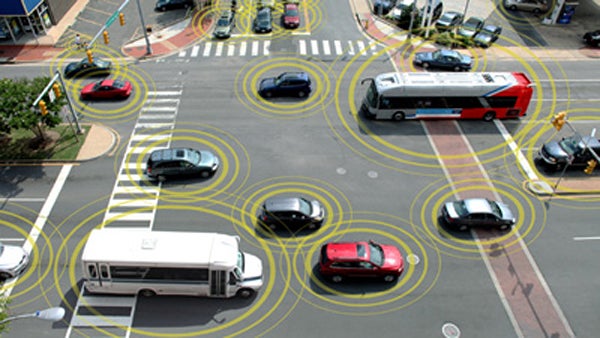Could ‘connected vehicle technology’ have prevented this South Jersey school bus crash?

Experts say connected vehicles are "right on the horizon." (Image courtesy of National Highway Traffic Safety Administration)
In February 2012 in Chesterfield, N.J., a school bus was T-boned by a speeding dump truck. The crash killed an 11-year-old girl.
The subsequent investigation by the National Transportation Safety Board (NTSB) found plenty of human error.
But in her recent closing remarks on the Chesterfield crash, NTSB Chairman Deborah Hersman was clear:
“Connected vehicle technology — where vehicles communicate with other vehicles — holds great promise to reduce the tremendous death toll resulting from intersection crashes [like this one],” said Hersman.
Hersman called on another federal agency to take up the charge, enlisting the National Highway Traffic Safety Administration (NHTSA) to develop minimum performance standards for vehicles that can “talk” to each other.
The hope, NTSB says, is to one day outfit all vehicles with a modified version of Wi-Fi that enables short-range communication.
“The board believes that connected vehicle technology would be a safety boon for the entire U.S. vehicle fleet,” said NTSB spokesman Eric Weiss. “That would save lives for everyone.”
The NHTSA recently announced it was extending a yearlong study, putting Wi-Fi-connected cars through their paces at a facility in Michigan.
“Additional tests will allow for further examination of the technology on motorcycles and Vehicle to Infrastructure (V2I) applications, and will help inform the National Highway Traffic Safety Administration’s (NHTSA) decision on heavy vehicles in 2014,” the U.S. Department of Transportation said in a statement.
‘On the horizon’
Experts say cars that talk to each other are no longer a distant prospect of science fiction.
“This technology is inevitable,” said Dario Salvucci, a computer science professor at Drexel University who studies such technologies. “We need to plan for it starting right now.”
Despite some concerns about implementation, Salvucci sees vehicle-to-vehicle communication as a good thing. Within a decade or so, he says, it’ll be commonplace.
“It’s right on the horizon,” Salvucci said.
Intersection crashes accounted for 7,265 of the 32,367 U.S. highway deaths in 2011 alone.
According to the NTSB, school buses are more than six times safer than passenger vehicles for transporting children to and from school.
WHYY is your source for fact-based, in-depth journalism and information. As a nonprofit organization, we rely on financial support from readers like you. Please give today.




